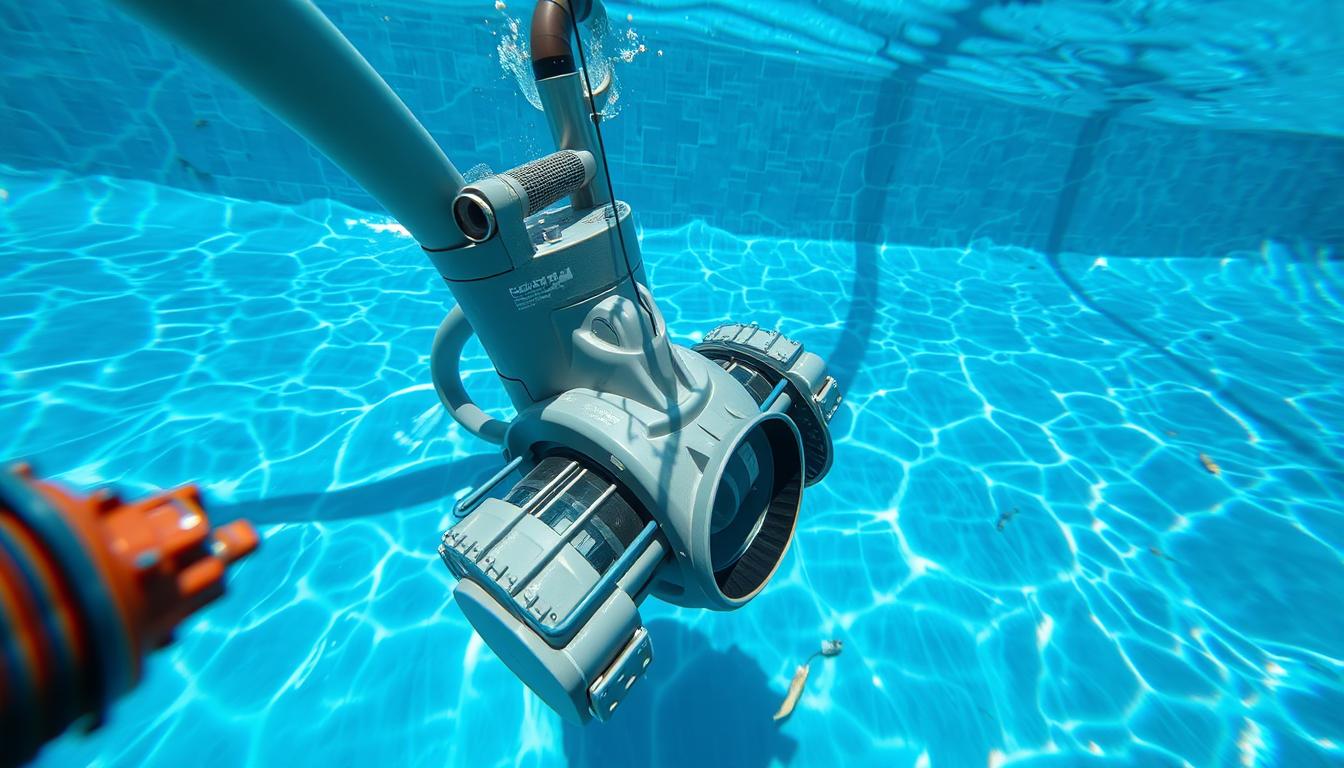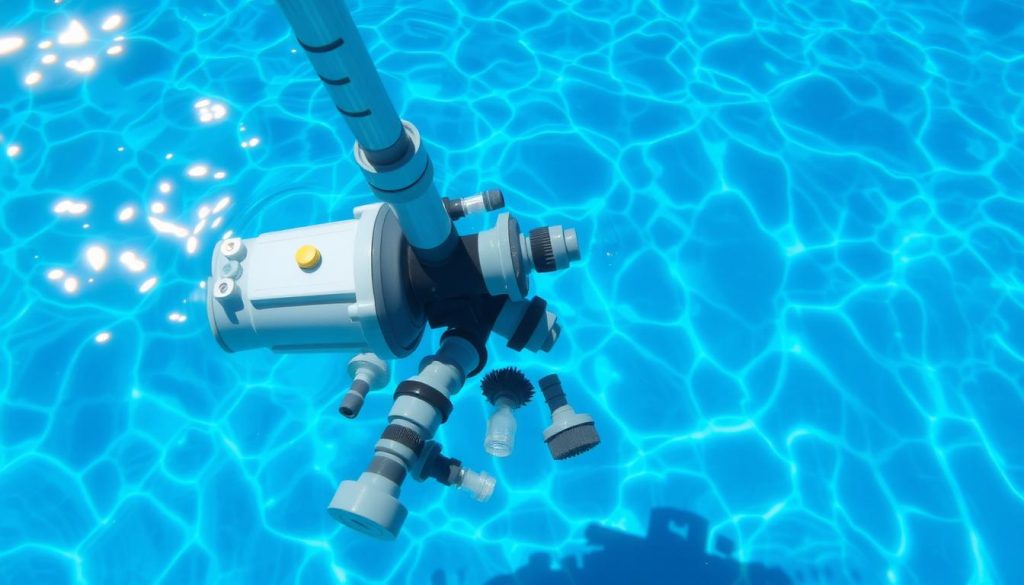
Pool vacuums are vital for keeping pools clean. They remove debris from floors and walls. But what if your vacuum stops moving? Let’s explore some troubleshooting tips.
There are three types of automatic pool cleaners. These include suction cleaners, robotic cleaners, and pressure cleaners. Each type can face different issues that stop them from moving.
Robotic cleaners may have power supply or filter problems. Suction cleaners often face clogging or air leaks. Pressure cleaners might struggle with low water pressure or clogged filter bags.
Before troubleshooting, check if all equipment works properly. This includes the pump, filter, and chlorinator. Addressing these basics first can save time and money.
In the following sections, we’ll focus on suction cleaners. We’ll provide step-by-step guidance for common issues. These may include hose problems or debris clogs.
Together, we’ll get your pool vacuum moving again. This will help restore your pool to its best condition.
Identifying Common Issues with Pool Vacuums
Pool vacuums can face several problems that affect their performance. Let’s look at common issues like suction problems, clogged filters, and worn-out parts. Understanding these can help keep your pool clean and inviting.
Suction Problems Caused by Blockages or Air Leaks
Suction issues often prevent pool vacuums from moving. Blockages in the hose or intake can stop water and debris flow. Air leaks in connections can also disrupt suction.
To fix this, check the hose and intake for obstructions. Make sure all connections are tight and airtight.
Clogged Filters and Skimmer Baskets
Clogged pool filters or skimmer baskets can slow down or stop vacuums. These parts restrict water flow when full of leaves and debris. This reduces the cleaner’s suction power.
Clean the skimmer basket regularly. Also, maintain the pool filter as needed. Change the sand in pool filters every 3-5 years.
| Component | Cleaning Frequency | Impact on Pool Vacuum Performance |
|---|---|---|
| Skimmer Basket | Daily or as needed | A full skimmer basket reduces water flow and slows down the cleaner |
| Pool Filter | Every 3-5 years (sand change) | A congested filter is the most common cause for slow or halted movement |
Worn-out Brushes, Flaps, and Hoses
Pool vacuum parts can wear out over time. This leads to reduced cleaning power and mobility issues. Damaged brushes and suction vents may not clean the pool surface well.
Worn-out skirts can cause the device to climb walls too much. Short, tangled, or holey hoses can limit movement. Replace these parts regularly for effective cleaning.
The pool cleaner’s hose should ideally reach the farthest point of the pool with an additional 1 meter to spare for thorough cleaning.
Addressing these issues helps keep pool vacuums working well. Regular maintenance ensures your pool stays clean and enjoyable.
Troubleshooting Suction Pool Vacuums
Is your suction pool vacuum not moving? Don’t worry! We’ll help you fix it quickly. Let’s look at common issues like pool vacuum hose clogs, pool vacuum air leaks, pool vacuum diaphragm issues, and adjusting pool vacuum suction.
With these simple steps, you’ll have your pool vacuum working again soon. Your pool will be sparkling clean in no time!
Checking the Hose and Skimmer Basket for Clogs
First, check for blockages in the hose and skimmer basket. Look for stuck leaves, twigs, or small toys. These can stop your vacuum from moving well.
Inspect the whole hose and remove any clogs you find. Don’t forget to clean out the skimmer basket too. A full basket can weaken suction power.
Inspecting for Air Leaks in the Vacuum Hose
Air leaks in the hose can also cause problems. To check, run your hand along the working hose. Listen for hissing sounds as you lift it out of the water.
Feel for air being sucked into the hose. If you find a leak, you might need to replace the hose.
Examining the Diaphragm for Blockages or Tears
The diaphragm inside the pool vacuum can cause issues too. Turn off your pump and filter before checking it. Then, take apart the cleaner and remove the diaphragm.
Look closely for any damage, tears, or blockages. Replace the diaphragm if needed to fix your pool vacuum.
Maintaining optimal water quality requires regular checks on the filter, skimmer basket, and water chemistry.
Adjusting the Flow Control Valve for Proper Suction
If your vacuum still won’t move, check the flow control valve. This valve controls the suction level to the cleaner. It’s in the skimmer box.
Try different settings until you find the right balance. This will help your vacuum move well and climb walls easily.
| Problem | Solution |
|---|---|
| Pool vacuum hose clogs | Inspect and clean the hose, removing any blockages |
| Pool vacuum air leaks | Check for leaks and replace the hose if necessary |
| Pool vacuum diaphragm issues | Examine the diaphragm for damage or tears and replace if needed |
| Adjusting pool vacuum suction | Fine-tune the flow control valve in the skimmer box for optimal performance |
Why Is My Pool Vacuum Not Moving
Is your pool vacuum stuck? Several issues could be causing this problem. Let’s explore common reasons why your vacuum might not be working properly.
Insufficient Water Level Covering the Weir and Return Jets
Low water levels often cause pool vacuums to stop moving. Your pool’s water should cover the weir and return jets. If it’s too low, suction issues can occur.
This problem is common during hot weather or after lots of swimming. Check your pool’s water level regularly to avoid this issue.
Improperly Fitted Weir Lid or Loose Hose Connections
A poorly fitted weir lid can also cause vacuum problems. Make sure it’s securely in place. Check your vacuum hose connections for tightness and leaks.
Loose connections let air enter the system. This disrupts suction and stops the vacuum from moving properly.

Damaged or Torn Vacuum Hose
A damaged hose can lead to a stationary vacuum. Look for splits, tears, or holes in the hose. Even small holes can let air in and weaken suction power.
If you find any damage, replace the hose. This will help restore your vacuum’s functionality.
Debris Clogging the Vacuum Intake or Hose
Debris can clog your vacuum’s intake or hose. This restricts water flow and stops the cleaner from moving. Leaves and twigs are common culprits.
Check for visible obstructions regularly. Remove any debris you find to keep your vacuum working well.
| Problem | Solution |
|---|---|
| Insufficient water level | Ensure water level covers weir and return jets |
| Improperly fitted parts | Secure weir lid and tighten hose connections |
| Damaged vacuum hose | Inspect hose for damage and replace if necessary |
| Debris clogging | Remove obstructions from vacuum intake and hose |
Fixing these issues will help your pool vacuum move smoothly. Regular maintenance is key to keeping your pool clean. Address problems quickly to keep your vacuum working effectively.
Maintaining Your Pool Vacuum for Optimal Performance
Regular cleaning and maintenance are key to keeping pool vacuums running smoothly. A little upkeep can prevent common issues and extend equipment life. Following best practices ensures peak performance of your pool vacuum.
Clean the filter and baskets after each use. This prevents clogs and maintains strong suction power. Remove debris from the skimmer, pump baskets, and vacuum’s filter bag or canister.
Check the vacuum hose, brushes, and skirts often. Replace worn parts to keep cleaning efficiency high. This simple step can make a big difference in your vacuum’s performance.
Proper storage is vital, especially during off-seasons. Be careful when coiling the hose for storage. Incorrect storage can cause the hose to develop a coil memory.
A coiled hose makes it hard for the cleaner to move freely. To fix this, lay the hose straight in the sun. This helps it return to its original shape.
Quick action on maintenance issues keeps pools clean and inviting. By following these tips, your pool vacuum will serve you well all season long.







